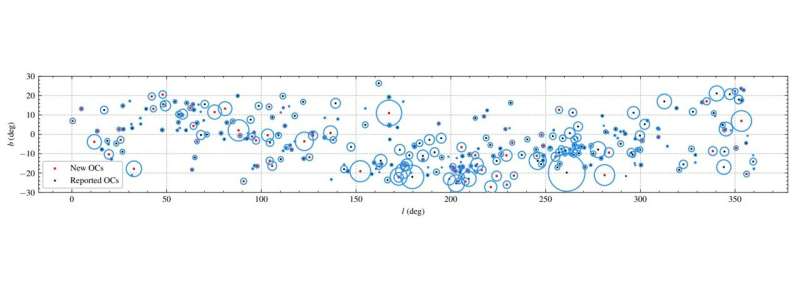
By analyzing the data from ESA’s Gaia satellite, astronomers from the Shanghai Astronomical Observatory (SHAO) in China have detected 101 new open clusters in the Milky Way galaxy. The discovery was presented in a paper published December 21 on the arXiv pre-print repository.
Open clusters (OCs), formed from the same giant molecular cloud, are groups of stars loosely gravitationally bound to each other. So far, more than 1,000 of them have been discovered in the Milky Way, and scientists are still looking for more, hoping to find a variety of these stellar groupings. Studying them in detail could be crucial for improving our understanding of the formation and evolution of our galaxy.
Now, a team of astronomers led by SHAO’s Qin Songmei reports the finding of 101 new OCs in the solar neighborhood. The discovery is a result of utilizing clustering algorithms pyUPMASK and HDSBSCAN on the data from Gaia’s Data Release 3 (DR3).
“In this paper, we performed a systematically blind search for OCs at Galactic latitudes |b| ≤ 30◦ within 500 pc of the solar neighborhood by choosing different slicing box sizes in different distance grids with Gaia DR3 data. (…) Our classification based on manual inspection not only marks new clusters but also combines some duplicate or partially reported clusters,” the researchers explained.
Songmei’s team managed to identify 324 open clusters, 101 of which were previously unreported. Therefore, the discovery increased the number of known nearby (within 1,600 light years from the Earth) OCs by about 45 percent. When it comes to the known 223 clusters, their parameters were updated by carefully comparing the spatial distribution and other properties with the previous cluster catalog.
Among the newly found open clusters there are 19 OC pairs with a common origin, whose age differences are less than 30 million years. Moreover, there are also three groups containing triple OCs, with spatial separation of less than 65 light years and age differences of less than 10 million years. The astronomers suppose that these triplets formed together from the same molecular cloud.
The researchers added that many nearby OCs with large spatial scales were discovered for the first time using their “slicing” approach. They underlined that their technique is therefore very effective for searching nearby OCs with a large spatial distribution. It also showed that many open clusters have an extended outer structure.
In concluding remarks, the authors of the paper noted that more detailed analyses are needed in order to shed more light on the properties of the newfound OCs, such as the mass function and the dynamical states. According to them, more spectroscopic data for the member stars will be of prime importance to determine the dynamical and chemical evolution of these clusters.
More information:
Songmei Qin et al, Hunting for Neighboring Open Clusters with Gaia DR3: 101 New Open Clusters within 500 pc, arXiv (2022). DOI: 10.48550/arxiv.2212.11034
Journal information:
arXiv
© 2022 Science X Network
Chinese astronomers detect over 100 new open clusters (2022, December 30)
retrieved 31 December 2022
from https://phys.org/news/2022-12-chinese-astronomers-clusters.html
part may be reproduced without the written permission. The content is provided for information purposes only.